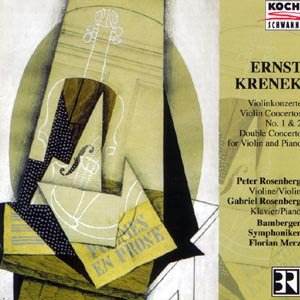Ernst Krenek (1900-1991) was a prolific, stylistic
chameleon of a composer, who made 'good enemies' on all sides and remains
hard to evaluate. This is a valuable collection of three concertos involving
the violin, played with impressive assurance by Peter Rosenberg, who
is joined by his brother Gabriel (they were a prize-winning duo) in
the Double Concerto Op 124 of 1950, perhaps the most attractively accessible
of the three.
The compact first concerto Op 29 (1924) [22'43] has
affiliations with the neo-classical Stravinsky of the time, and its
orchestration brings Hindemith to mind. The orchestra is small and the
textures transparent. It is a piece of considerable originality, which
rewards familiarity. Although Krenek is quoted as describing it as 'fairly
straightforward as regards structure and form', it would have helped
if Koch had encouraged 'EvH', the writer of the comprehensive and illuminating
biographical and analytic liner notes, to provide timings for the numerous
inter-related sub-sections. After three hearings, I find it still impossible
to pinpoint the landmarks cited in the commentary, so frequent are the
tempo changes. With certainty I can say that the extensive cadenza is
from 15'35-18'50, and that there is no problem with the brief presto
finale, 21'52, ending with bassoon and piccolo remain playing with the
soloist, before he is left completely on his own to take his leave,
at the highest register and without slackening the tempo.
The 33 min. Op 140 (1954) is in the traditional three
movements, scored with a massive orchestra and incorporating thematic
transformations between the movements. 'Colossal - - taut, fiery and
bold', it is rated very highly by one commentator quoted, John Stewart,
and 'EvH' believes that its Adagio 'reaches the stature of Berg's violin
concerto, a great symphonic movement with its natural use of serial
technique and feeling, expression, inspiration'.
Even easier to enjoy is the Double Concerto of 1950,
seven short movements permeated by Austrian folk-dance rhythms, the
last in Tempo di Landler. Performances, recording and, especially,
balance are exemplary and this release is a welcome addition to an increasing
Krenek discography and contribution to the composer's rehabilitation.
Peter Grahame Woolf

![]() Peter Rosenberg (violin)/Gabriel
Rosenberg (piano)/Bamberger Symphoniker/Florian Merz
Peter Rosenberg (violin)/Gabriel
Rosenberg (piano)/Bamberger Symphoniker/Florian Merz![]() Koch-Schwann 3-6408-2
[73 mins]
Koch-Schwann 3-6408-2
[73 mins]